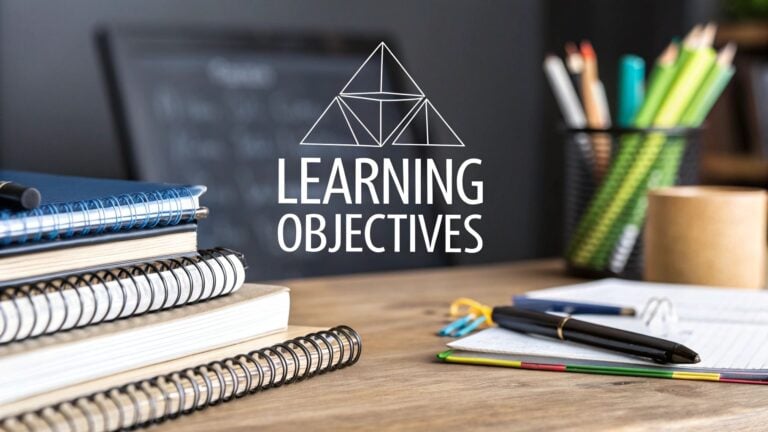7 Great Examples of Micro Learning to Inspire You

Hey there, Jason here from LearnStream. If you’ve been around the e-learning block, you’ve probably heard the term ‘microlearning’ thrown around a lot. It can sound a bit like corporate jargon, but the idea behind it is actually pretty simple. It’s all about delivering learning content in small, focused, and easily digestible chunks.
Think of it as a quick snack for your brain instead of a three-course meal. This approach is perfectly suited for how we all consume information today, on the go and often with limited time. It respects the learner’s schedule and attention span, making it a super powerful tool for anyone creating courses or training materials.
In this article, I’m going to walk you through some of the best real-world examples of micro learning I’ve seen. We won’t just look at what they are. We’ll dive deep and break down the specific strategies that make them so effective. I’ll show you exactly why they work and how you can replicate their success in your own projects.
By the end, you’ll have a clear playbook full of actionable tactics for creating bite-sized learning experiences that really stick. Let’s get into it.
1. Duolingo’s Bite-Sized Language Lessons
Duolingo didn’t just create a language app, it created a blueprint for habit-forming microlearning. It stands as one of the most successful examples of micro learning because it deconstructs the huge task of learning a new language into playful, 5 to 15-minute daily sessions.
Instead of long grammar lectures, Duolingo presents focused exercises. You might spend a few minutes matching Spanish food vocabulary, practicing Japanese Hiragana characters, or getting instant audio feedback on your French pronunciation. This approach makes learning feel less like a chore and more like a quick game you can play on your lunch break.
The Strategic Breakdown
Duolingo’s success really comes down to a few key principles. First is gamification. The platform uses streaks, points, and leaderboards to create a compelling feedback loop that encourages daily participation. Missing a day means breaking your streak, which is a surprisingly powerful motivator for a lot of people.
Second is spaced repetition. The app’s algorithm tracks your performance, reintroducing concepts you struggle with at strategic intervals to reinforce your memory. This ensures you’re always building on a solid foundation of knowledge.
Key Insight: Duolingo proves that consistency, driven by gamification and personalization, is more effective than occasional, long study sessions. The goal is to build an effortless daily habit.
Actionable Takeaways for Your Courses
You can replicate Duolingo’s model in almost any subject.
- Atomize Your Content: Break down large topics into the smallest possible learning units. A lesson on digital marketing could become a 5-minute quiz on SEO terms or a short video on writing effective ad copy.
- Gamify Progression: Introduce simple point systems, badges for completing modules, or a “learning streak” tracker to motivate users to return daily.
- Implement Smart Repetition: Use quizzes that pull from a bank of previously covered topics to keep information fresh. Identify weak spots and prompt learners to review those specific micro-lessons.
Duolingo’s approach is perfect for foundational knowledge, skill drills, and compliance training where consistent, small efforts lead to long-term mastery. To dive deeper into these tactics, explore these microlearning best practices for more ideas on implementation.
2. TikTok Educational Content (#LearnOnTikTok)
TikTok has evolved far beyond dance challenges and has become an accidental but powerful platform for microlearning. The #LearnOnTikTok initiative shows how experts can distill complex topics into engaging, 60-second videos. This format is a prime example of micro learning because it leverages entertainment and visual storytelling to deliver knowledge in highly digestible, memorable bursts.
Creators like Dr. Karan Rajan explain medical concepts, while others teach coding snippets or summarize historical events in the time it takes to make a coffee. The platform’s algorithm-driven feed delivers these micro-lessons directly to users, making learning a fun and integrated part of their daily scrolling.
The Strategic Breakdown
TikTok’s educational success relies on two core elements. First is high-impact delivery. Creators use trending audio, quick cuts, and on-screen text to grab attention and convey information efficiently. This visual and auditory stimulation helps encode information more effectively than plain text or a static image.
Second is contextual learning. The content feels native to the platform and blends in with entertainment. This lowers the cognitive barrier to entry, making users more receptive to learning because it doesn’t feel like a formal lesson. It’s education disguised as entertainment.
Key Insight: TikTok proves that learning doesn’t need a formal setting. By pairing educational content with popular entertainment formats, you can capture attention and deliver knowledge to learners where they already are.
Actionable Takeaways for Your Courses
You can channel the TikTok model to make your own content more dynamic and accessible.
- Create “Scroll-Stopping” Hooks: Start your videos or lessons with a provocative question, a surprising fact, or a visually interesting clip to immediately capture learner attention.
- Use Visual Storytelling: Instead of just talking, show the concept. Use quick edits, text overlays, and simple graphics to explain processes or highlight key takeaways. A short screen recording of a single software function is more effective than a paragraph explaining it.
- Embrace Brevity: Challenge yourself to explain one single concept in 60 seconds or less. This forces you to be clear and concise, focusing only on the most critical information your learner needs to know right now.
This approach is great for just-in-time learning, performance support, and generating interest in a larger topic. It’s perfect for providing quick tips, busting common myths, or offering a behind-the-scenes look at a complex process.
3. Kahoot! Interactive Quiz Platform
Kahoot! took the traditional quiz and turned it into a vibrant, competitive event, solidifying its place among the most engaging examples of micro learning. It transforms knowledge checks from solitary assessments into live, game-show-style competitions that are perfect for groups.
Participants use their own devices to answer timed questions on a shared screen, creating a lively and focused learning moment. Whether it’s a corporate training session on new company policies or a university lecture review, Kahoot! makes learning active, social, and memorable in short, high-energy bursts.
The Strategic Breakdown
Kahoot!’s effectiveness comes from its blend of social learning and immediate feedback. First is its use of competition and urgency. The platform awards points for both correctness and speed, creating a low-stakes, competitive environment that keeps learners fully engaged and focused on the content.
Second is its shared experience model. Unlike solo quizzes, Kahoot! is designed for group participation. This collective energy turns a review session into a memorable team event, reinforcing concepts through shared excitement and discussion. For those interested in other engaging quiz tools, you might find valuable insights into alternatives to interactive quiz platforms like Quizizz that leverage similar social dynamics.
Key Insight: Kahoot! demonstrates that microlearning can be a powerful tool for social and collaborative environments. The combination of speed, competition, and group dynamics dramatically boosts engagement and knowledge retention.
Actionable Takeaways for Your Courses
You can integrate Kahoot!’s energetic approach into your own training and teaching.
- Create Live Review Sessions: Use the platform to host a 15-minute quiz at the end of a module or a live webinar to instantly gauge understanding and reinforce key topics.
- Encourage Peer Learning: After a quiz, use the results to spark a group discussion. Ask why a certain answer was correct or why a common wrong answer was chosen.
- Incorporate Rich Media: Use images and short video clips in your questions to cater to visual learners and make the content more dynamic and appealing.
This approach is ideal for live training events, classroom reviews, and team-building activities where you need to capture attention and make learning stick. To learn more about building compelling assessments, explore these tips on making online course quizzes interactive and engaging.
4. LinkedIn Learning Daily Skills

LinkedIn Learning has mastered professional development on the go, making it one of the most effective examples of micro learning for the corporate world. It delivers a huge library of expert-led courses broken down into short, digestible video lessons, most of which are just 3 to 10 minutes long.
Instead of blocking out hours for a training seminar, a professional can learn a new Excel formula during their coffee break, watch a video on leadership communication before a big meeting, or grasp a new project management technique while commuting. The platform transforms learning from a scheduled event into an on-demand, integrated part of the workday.
The Strategic Breakdown
LinkedIn Learning’s strategy is built on relevance and accessibility. It seamlessly integrates with a user’s professional profile, suggesting courses based on their industry, career goals, and skills they want to develop. This personalization ensures that every micro-lesson feels immediately valuable.
The platform also excels at just-in-time learning. Professionals can search for a specific skill they need at that very moment, get a concise and practical answer from a credible expert, and apply it to their work immediately. This direct application reinforces the knowledge and shows its real-world value.
Key Insight: LinkedIn Learning proves that professional development is most effective when it is contextual, on-demand, and fits neatly into the gaps of a busy schedule. The goal is to provide immediate answers to real-world work challenges.
Actionable Takeaways for Your Courses
You can adopt this “just-in-time” model for your own training programs.
- Create a Searchable Knowledge Hub: Organize your content with clear, intuitive tags and titles. Your learners should be able to quickly find a 5-minute video that solves a specific problem they are facing right now.
- Focus on Immediate Application: Frame each micro-lesson around a specific task or problem. A lesson on email marketing could be “Writing a Subject Line That Gets Opened” rather than a general overview of email campaigns.
- Leverage Expert Voices: Use subject matter experts to deliver content. Their credibility and real-world experience make the short lessons more impactful and trustworthy for learners seeking quick, reliable solutions.
This approach is ideal for corporate training, continuing professional education, and any skill-based learning where learners need quick, reliable answers to workplace challenges. For more ideas, you can explore the LinkedIn Learning platform directly.
5. Anki Flashcard Spaced Repetition
Anki is less a single course and more a powerful, open-source engine for memory retention. It serves as one of the most potent examples of micro learning by taking the simple concept of flashcards and supercharging it with a scientifically-backed algorithm. It’s designed for one purpose, to help you remember vast amounts of information efficiently.
Instead of generic daily lessons, Anki offers hyper-personalized review sessions that take just a few minutes. You might spend five minutes reviewing complex medical terminology, ten minutes drilling Japanese Kanji, or seven minutes memorizing legal precedents for the bar exam. Each session is uniquely tailored to what your brain is most likely to forget, which makes every minute of study incredibly effective.
The Strategic Breakdown
Anki’s power is rooted in two core concepts. First is active recall. The platform forces you to actively retrieve information from memory rather than passively recognizing it. This mental effort creates stronger neural pathways and makes the information stick. You aren’t just reading a fact, you are proving to yourself that you know it.
Second is spaced repetition. Anki’s algorithm, based on the SM-2 model, schedules when you will see a flashcard again. If you answer easily, the interval increases from days to weeks or months. If you struggle, you’ll see the card again very soon. This automates the process of reviewing information at the perfect moment before you forget it.
Key Insight: Anki shows that microlearning is about delivering the right micro-lesson at the precise moment it’s needed to combat the brain’s natural forgetting curve. It’s about smart delivery, not just small content.
Actionable Takeaways for Your Courses
You can integrate Anki’s principles to boost long-term retention in any learning program.
- Create Digital Flashcard Decks: For any course heavy on terminology, formulas, or key concepts, provide learners with a pre-made Anki deck. This adds immense value and helps them master foundational knowledge.
- Encourage Active Recall: Design quizzes and activities that require learners to type out answers from memory instead of just selecting from multiple-choice options.
- Automate Review Reminders: While you may not have a full algorithm, you can use email automation to send “refresher” quizzes or short concept reminders one week, one month, and three months after a module is completed.
Anki’s model is perfect for knowledge-intensive fields like medicine, law, engineering, and language acquisition, where committing a large volume of facts to long-term memory is critical for success.
6. Just-in-Time Training Modules

Just-in-time (JIT) training moves learning from the classroom directly to the workflow. It stands out as one of the most practical examples of micro learning by delivering specific, contextual information at the precise moment of need. An employee can get immediate, bite-sized support instead of relying on memory from a training session held weeks ago.
Imagine a manufacturing technician scanning a QR code on a machine to pull up a 30-second video on a specific assembly step. Or think about a customer service agent accessing a pop-up script for a rare customer complaint. This approach provides answers, not courses, embedding learning seamlessly into daily tasks.
The Strategic Breakdown
The power of just-in-time learning lies in its focus on performance support. The main goal here is immediate task proficiency, not necessarily long-term knowledge retention. It answers the question, “How do I do this right now?” This reduces cognitive load and minimizes errors by providing the right information at the right time.
Another key principle is contextual relevance. The content is designed for a specific task, environment, or problem. A safety checklist delivered to a construction worker’s phone at a job site is far more effective than a generic safety manual. This direct application reinforces the learning and shows its immediate value.
Key Insight: Just-in-time training transforms learning from a scheduled event into an on-demand utility. It prioritizes immediate application and problem-solving over abstract knowledge acquisition.
Actionable Takeaways for Your Courses
You can integrate a JIT approach to support learners beyond the formal course environment.
- Create a Performance Support Hub: Build a searchable library of short videos, checklists, and quick reference guides that learners can access from their mobile devices when they are applying their new skills on the job.
- Use Contextual Triggers: Link your micro-assets to real-world triggers. Use QR codes on equipment, links within software applications, or location-based notifications to push relevant information to users when and where they need it.
- Design for Speed and Clarity: JIT content must be scannable and instantly understandable. Use clear headings, visuals, and simple language. A technician doesn’t have time to read a lengthy article, they need a clear diagram or a bulleted list.
This model is ideal for procedural tasks, technical troubleshooting, and compliance reinforcement where accuracy and immediacy are critical. To get a better handle on organizing this type of content, see these tips on how to structure microlearning content for maximum impact.
7. Grammarly Writing Assistance
Grammarly transforms every writing task into a live coaching session, making it a powerful, real-time example of micro learning. Users don’t need to seek out lessons on grammar or style. Instead, Grammarly brings the learning directly into their workflow, whether they’re drafting an email, writing a report, or posting on social media.
The tool provides instant, contextual feedback through its browser extensions and applications. As you type, it highlights potential issues and offers suggestions with clear explanations. One moment you’re learning about comma splices, and the next you’re discovering a more concise way to phrase a sentence. This “just-in-time” learning is incredibly effective because the feedback is immediately relevant to what the user is doing.
The Strategic Breakdown
Grammarly’s effectiveness is rooted in its seamless integration and contextual relevance. First is workflow learning. It meets users exactly where they are, eliminating the friction of switching between a writing document and a separate learning platform. The lesson is delivered at the precise moment of need.
Second is scaffolded feedback. Grammarly doesn’t just correct mistakes, it explains the “why” behind them. This explanation turns a simple correction into a durable learning moment. It helps users understand the underlying rules of grammar, clarity, and tone so they can avoid repeating the same error.
Key Insight: The most effective learning happens in the flow of work. By embedding micro-lessons directly into the user’s daily tasks, Grammarly makes continuous improvement an effortless background process.
Actionable Takeaways for Your Courses
You can apply Grammarly’s principles to provide feedback and reinforcement within your own programs.
- Provide Just-in-Time Support: Integrate tool-tips or short pop-up video explanations within complex modules. When a learner hovers over a key term or concept, give them a bite-sized definition or example.
- Explain the “Why”: When a learner answers a quiz question incorrectly, don’t just show the right answer. Provide a concise, clear explanation of why their choice was wrong and why the correct answer is right.
- Use Data for Personalized Nudges: Track common error patterns and send targeted micro-lessons to learners who struggle with specific topics. This proactive approach reinforces knowledge where it’s weakest.
This model is great for skill development, performance support, and any training where application is key. Beyond specific writing assistance like Grammarly, exploring various AI tools for content creators can streamline the development of diverse microlearning content.
Microlearning Examples Comparison Guide
| Microlearning Example | Implementation Complexity | Expected Outcomes | Ideal Use Cases | Key Advantages |
|---|---|---|---|---|
| Duolingo’s Bite-Sized Language Lessons | Moderate | Improved language basics & retention | Individual language learners | Accessible, gamified, personalized pacing |
| TikTok Educational Content (#LearnOnTikTok) | Low | Quick knowledge absorption, high engagement | Broad informal learning, viral content | High engagement, visual/audio learning |
| Kahoot! Interactive Quiz Platform | Moderate | Enhanced recall, group engagement | Classroom, corporate training | Competition-driven, immediate feedback |
| LinkedIn Learning Daily Skills | Moderate | Career-relevant skill acquisition | Busy professionals | Professional quality content, career focus |
| Anki Flashcard Spaced Repetition | Moderate to High | Long-term memory retention | Memorization-heavy subjects | Scientifically proven, customizable |
| Just-in-Time Training Modules | High | Immediate job performance improvement | Workplace training, on-demand tasks | Contextual, reduces errors, real-time support |
| Grammarly Writing Assistance | High | Progressive writing skill improvement | Writers, professionals | Immediate contextual feedback, multiplatform |
Putting It All Together: Your Microlearning Game Plan
We’ve just walked through some powerful examples of micro learning, from Duolingo’s gamified language lessons to Grammarly’s real-time writing tips. This journey has shown us that effective learning often comes from delivering the right information, at the right moment, in the most digestible way possible. It isn’t always about long-form courses or dense textbooks.
The core principle tying all these examples together is intentional design. None of these experiences are random. They are carefully crafted to solve a specific problem or teach a single concept quickly and efficiently. TikTok creators know they have seconds to grab attention, so they front-load value. Anki is built entirely around the cognitive science of memory. LinkedIn Learning delivers professional skills that fit into a busy workday.
This is where the true opportunity lies for you as a creator, trainer, or educator.
Your Actionable Takeaways
So, what are the big lessons we can pull from these case studies? The most successful microlearning initiatives all share a few key strategic ingredients.
Focus on a Single Objective: Every micro-lesson should have one, and only one, clear goal. As we saw with Kahoot!, a single quiz question is designed to test one piece of knowledge. Resist the urge to cram too much information into one small package.
Context is King: The best microlearning feels like it belongs in the moment. Just-in-time training modules for software are effective because they appear exactly when the user needs help. Think about your learner’s environment. Are they on a noisy commute? At their desk trying to solve a problem? Design for that context.
Make it Interactive and Engaging: Passive learning is forgettable learning. Duolingo doesn’t just show you a word, it makes you type it, say it, and match it. Even a simple checklist or a one-question poll can transform a passive experience into an active one, which boosts retention significantly.
Embrace Spaced Repetition: As Anki perfectly demonstrates, learning isn’t a one-time event. Build in mechanisms to bring learners back to key concepts over time. This could be a follow-up email with a quick quiz, a weekly “did you know?” notification, or a series of short, related videos released over several days.
Your Next Steps
Feeling inspired? Good. Now it’s time to turn that inspiration into action. You don’t need a massive budget or a team of developers to get started.
Begin by identifying one small, high-impact piece of knowledge from your existing content. Maybe it’s a single, crucial concept from a larger course or a common question your audience always asks.
Now, challenge yourself to create one micro-asset around it. Can you make a 60-second video tutorial? A downloadable infographic? An interactive quiz with three questions?
By starting small, you can test what resonates with your audience and build momentum. The power of exploring these examples of micro learning is about getting a blueprint for your own success, not just admiring what others have built. Go create something small but mighty.






